OPERATION
Fig.1
• Ensure that there is sufficient water in the water
reservoir (4) before starting work, i.e. enough to
allow the diamond blade to pass through the water.
During work activities, the water must be topped up
through the fill opening (6).
• Do not start work until the correct rotational speed
has been reached.
• Diamond blades may NEVER be exposed to sidelong
pressure! This can cause them to break. Flying pieces
act as missiles and are highly dangerous!
• Do not attempt to cut very small pieces of stone.
During work, always make sure that the entire sur-
face of the stone is resting on the work table. The
mitre guide (supplied) can be used to slide paving sto-
nes through the machine. Ensure that the paving
stone remains level, especially in the initial cutting
phase. Doing this prevents the blade from jolting
upwards during cutting.
• Do not overload your tools. Your work is carried out
better and safer within the given capacity range. Do
not cut other materials other than paving stones or
tiles.
• Meticulously maintain your tools. Keep your tools
sharp and clean in order to be able to work safely and
correctly. Follow the maintenance instructions and
the directions concerning replacement of the dia-
mond blade.
• Ensure that you stand in a safe position and always
keep your balance. Avoid unnatural bodily positions.
Be constantly on your guard. Use caution in everyt-
hing that you carry out. Be sensible at work. Do not
use the machine if you are not able to concentrate or
if you are tired.
CUTTING GUIDE
Fig.1
It is possible to cut parallel to another guiding edge using
the cutting guide (3).
Adjustment: undo the knobs (7) and adjust to the desired
distance. Retighten the knobs. The markings (8) indicate
the measurement.
MITRE ANGLE ADJUSTMENT
Fig.1
The mitre angle can be variably adjusted from 0° to 45°.
Undo the star-shaped knobs (5) and adjust the mitre
angle by tilting the table (1) upwards until the desired gra-
dient is reached. Finally, retighten the knobs (5).
CLEANING, MAINTENANCE AND
REPAIRS
• Remove the plug from the wall socket after use and
before cleaning the machine, replacing the diamond
blade or interchanging the water reservoir.
• The machine is cleaned immediately after use as fol-
lows:
a. Remove the plug from the wall socket.
b. Remove the water reservoir from the machi
ne and allow the dirty water to drain away.
c. Unscrew the water splashback cover and
clean this.
d. Undo the star-shaped knobs, fold the table
upwards and clean the entire machine.
• The machine complies with the current safety pre-
conditions. All repair work may only be performed
by a recognised company as unauthorised repair
attempts can carry the risk of injury to the user or to
bystanders. Regularly check the plug and cable and
allow these to be replaced by a recognised company
in the event of damage to either. Likewise, check the
extension cables. Damaged safety facilities and
switches should, in the correct manner, be replaced
in order to continue using the machine.
CHECKING AND REPLACING THE DIA-
MOND BLADE
• Diamond blades that are cracked or distorted should
be replaced.
• Type of blade: 150 mm diameter diamond blade.
• Diamond blades which do not comply with the speci-
fications laid down in this instruction manual may not
be used.
• The plug should be removed from the wall socket
before changing the blade and adjustment or cleaning
activities.
• Care should be taken to ensure that the diamond
blade is fitted securely and rotates in the correct
direction.
• To replace a worn blade you should proceed as fol-
lows (fig. 2):
a. Remove the plug from the wall socket.
b. Remove the water reservoir (4, fig. 1) from
the machine.
c. Undo and remove the attachment bolts for
the splashback cover.
d. Undo the nut which holds the blade in place
(4, fig. 2).
e. Remove the blade (2, fig. 2) and slide the
new blade onto the flange (1, fig. 2). Take care
to observe the direction of rotation which is
indicated by an arrow on the blade. Next, refit
the counterflange (3, fig. 2).
f. Retighten the nut which holds the blade in
place (4, fig. 2) and refit the water splashback
cover.
g. Be sure that you do not leave any tools
behind the water splashback cover.
4 Ferm
èË ˝ÍÒÔÎÛ‡Ú‡ˆËË ˝ÎÂÍÚ˘ÂÒÍËı χ¯ËÌ ‚Ò„‰‡
Òӷ≇ÈÚ ‰ÂÈÒÚ‚Û˛˘Ë ԇ‚Ë· ÚÂıÌËÍË
·ÂÁÓÔ‡ÒÌÓÒÚË ‰Îfl ÒÌËÊÂÌËfl ËÒ͇ ÔÓʇ‡,
ÔÓ‡ÊÂÌËfl ˝ÎÂÍÚ˘ÂÒÍËÏ ÚÓÍÓÏ Ë Ú‡‚Ï.
èÓ˜ËÚ‡ÈÚ ̇ÒÚÓfl˘Ë Ú·ӂ‡ÌËfl, ‡ Ú‡ÍÊÂ
‚ıÓ‰fl˘Û˛ ‚ ÍÓÏÔÎÂÍÚ ËÌÒÚÛÍˆË˛ ÔÓ ÚÂıÌËÍÂ
·ÂÁÓÔ‡ÒÌÓÒÚË.
ï‡ÌËÚ ËÌÒÚÛ͈ËË ‚ ÏÂÒÚÂ, Ó·ÂÒÔ˜˂‡˛˘ÂÏ
Ëı ÒÓı‡ÌÌÓÒÚ¸!
èêÄÇàãÄ íÖïçàäà ÅÖáéèÄëçéëíà
• è‰ ̇˜‡ÎÓÏ ‡·ÓÚ˚ ÌÛÊÌÓ Û·Â‰ËÚ¸Òfl ‚
ÓÚÒÛÚÒÚ‚ËË ÔÓ‚ÂʉÂÌËÈ Ì‡ ÒÚ‡ÌÍÂ, ÓÒÓ·ÂÌÌÓ Ì‡
ÂÊÛ˘ÂÏ ‰ËÒÍÂ. ÇÒ ˜‡ÒÚË ‰ÓÎÊÌ˚ ·˚Ú¸
Ô‡‚ËθÌÓ ÛÒÚ‡ÌÓ‚ÎÂÌ˚ ‚ ÒÓÓÚ‚ÂÚÒÚ‚ËË Ò
ÛÒÎÓ‚ËflÏË ‰Îfl Ó·ÂÒÔ˜ÂÌËfl ÓÔÚËχθÌÓÈ ‡·ÓÚ˚
ÒÚ‡Ì͇. èË ÔÓ‰ÓÎÊËÚÂθÌÓÏ ÂÊËÏ ‡·ÓÚ˚
ÒΉÛÂÚ ÔÓ‚ÂflÚ¸ ËÒÔ‡‚ÌÓÒÚ¸ Ë
‡·ÓÚÓÒÔÓÒÓ·ÌÓÒÚ¸ ËÁ̇¯Ë‚‡ÂÏ˚ı ËÎË Ò΄͇
ÔÓ‚ÂʉÂÌÌ˚ı ‰ÂÚ‡ÎÂÈ Ë Á‡˘ËÚÌ˚ı
ÔËÒÔÓÒÓ·ÎÂÌËÈ. ùÚÓ ‚˚ÔÓÎÌflÂÚÒfl ‚
ÒÓÓÚ‚ÂÚÒÚ‚ËË Ò ‚˚¯ÂÛÔÓÏflÌÛÚ˚ÏË ÛÒÎÓ‚ËflÏË.
Ñ‚ËÊÛ˘ËÂÒfl ˜‡ÒÚË - ÓÒÓ·ÂÌÌÓ Á‡˘ËÚÌ˚È ÍÓÊÛı
‰ËÒ͇ - ‰ÓÎÊÌ˚ ·˚Ú¸ Ô‡‚ËθÌÓ Á‡ÙËÍÒËÓ‚‡Ì˚ Ë
Ì ‰ÓÎÊÌ˚ Á‡Â‰‡Ú¸. á‡Ô¢‡ÂÚÒfl ËÒÔÓθÁÓ‚‡Ú¸
ÒÚ‡ÌÓÍ ·ÂÁ ÍÌÓÔÓÍ ‚Íβ˜ÂÌËfl-ÓÚÍβ˜ÂÌËfl.
• á‡Ô¢‡ÂÚÒfl ÒÌËχڸ Á‡˘ËÚÌ˚È ÍÓÊÛı ËÎË
‰ÓÔÓÎÌËÚÂθÌÓ ÙËÍÒËÓ‚‡Ú¸ Â„Ó Í‡ÍËÏË-ÚÓ
ÔËÒÔÓÒÓ·ÎÂÌËflÏË. á‡ÍÎËÌË‚¯ËÈ ÍÓÊÛı ÒΉÛÂÚ
ÌÂωÎÂÌÌÓ ÓÚÂÏÓÌÚËÓ‚‡Ú¸.
ìëíÄçéÇäÄ à çÄëíêéâäÄ
èãàíäéêÖáÄ
• ëÚ‡ÌÓÍ ÏÓÊÌÓ ËÒÔÓθÁÓ‚‡Ú¸ ÚÓθÍÓ Í
ÒÚ‡ˆËÓ̇ÌÓÏ ÂÊËÏÂ, Á‡ÙËÍÒËÓ‚‡‚ Â„Ó Í
Ó‚ÌÓÈ „ÓËÁÓÌڇθÌÓÈ ÔÓ‚ÂıÌÓÒÚË ˜ÂÂÁ
ÓÚ‚ÂÒÚËfl ‚ ÌËÊÌÂÈ ˜‡ÒÚË ÒÚ‡Ì͇.
• ç‡ÔflÊÂÌË ÒÂÚË ˝ÎÂÍÚÓÔËÚ‡ÌËfl ‚ ÓÁÂÚÍ ‰Îfl
ÔÓ‰Íβ˜ÂÌËfl ÒÚ‡Ì͇ ‰ÓÎÊÌÓ ·˚Ú¸ 230 Ç Ò
Á‡ÁÂÏÎÂÌËÂÏ Ë Á‡˘ËÚÓÈ ‡‚ÚÓχÚ˘ÂÒÍËÏ
ÔÂ˚‚‡ÚÂÎÂÏ ˆÂÔË. ëÂÚ‚Ó ̇ÔflÊÂÌËÂ
‰ÓÎÊÌÓ ÒÓÓÚ‚ÂÚÒÚ‚Ó‚‡Ú¸ ‚Â΢ËÌÂ, Û͇Á‡ÌÌÓÈ Ì‡
Á‡‚Ó‰ÒÍÓÈ Ú‡·Î˘ÍÂ.
• á‡Ô¢‡ÂÚÒfl ÓÚÒÓ‰ËÌflÚ¸ ‚ËÎÍÛ ÓÚ Ì‡ÒÚÂÌÌÓÈ
ÒÂÚ‚ÓÈ ÓÁÂÚÍË ‚˚Úfl„Ë‚‡ÌËÂÏ Á‡ ÒÂÚ‚ÓÈ ¯ÌÛ.
òÌÛ ÒΉÛÂÚ Á‡˘Ë˘‡Ú¸ ÓÚ ‚ÓÁ‰ÂÈÒÚ‚Ëfl
ËÒÚÓ˜ÌËÍÓ‚ ÚÂÔ·, ÓÚ Ï‡Ò· Ë ÓÒÚ˚ı Ô‰ÏÂÚÓ‚.
ÑÎfl ‚‡¯ÂÈ Î˘ÌÓÈ ·ÂÁÓÔ‡ÒÌÓÒÚË
‡Á¯‡ÂÚÒfl ÔËÏÂÌflÚ¸ ÚÓθÍÓ ÚÂ
Á‡Ô˜‡ÒÚË Ë ÔËÒÔÓÒÓ·ÎÂÌËfl, ÍÓÚÓ˚ Ô˜ËÒÎÂÌ˚ ‚
‰‡ÌÌÓÈ ËÌÒÚÛ͈ËË ÎË·Ó ÂÍÓÏẨӂ‡Ì˚
ÔÓËÁ‚Ó‰ËÚÂÎÂÏ Ï‡¯ËÌ˚. Ç ÔÓÚË‚ÌÓÏ ÒÎÛ˜‡Â Ç˚ Ò‡ÏË
ÔÓ‰‚„‡ÂÚÂÒ¸ Ë ÔÓ‰‚„‡ÂÚ ‰Û„Ëı ËÒÍÛ ÔÓÎÛ˜ÂÌËfl
Ú‡‚Ï˚.
êÄÅéíÄ çÄ ëíÄçäÖ
Fig.1
•è‰ ̇˜‡ÎÓÏ ‡·ÓÚ˚ Ó·ÂÒÔ˜¸Ú ̇΢ËÂ
‰ÓÒÚ‡ÚÓ˜ÌÓ„Ó ÍÓ΢ÂÒÚ‚‡ ‚Ó‰˚ ‚ ·‡˜Í (4) Ú‡Í,
˜ÚÓ·˚ ÌËÊÌflfl ˜‡ÒÚ¸ ÂÊÛ˘Â„Ó ‰ËÒ͇
ÔÓ„Ûʇ·Ҹ ‚ ÌÂÂ. èÓ‰ÎË‚ ‰Â·ÂÚÒfl ˜ÂÂÁ
ÒÔˆˇθÌÓ ÓÚ‚ÂÒÚË (6) ÔË ‡·ÓÚÂ.
• ç ̇˜Ë̇ÈÚ ‡·ÓÚÛ, ÔÓ͇ ‰ËÒÍ Ì ‰ÓÒÚË„ÌÂÚ
‰ÓÎÊÌÓÈ ÒÍÓÓÒÚË ‚‡˘ÂÌËfl.
• á‡Ô¢‡ÂÚÒfl ÔËÍ·‰˚‚‡Ú¸ Í ÂÊÛ˘ÂÏÛ ‰ËÒÍÛ
·ÓÍÓ‚Ó ‰‡‚ÎÂÌËÂ, Ú‡Í Í‡Í ˝ÚÓ ÏÓÊÂÚ ÔË‚ÂÒÚË Í
ÔÓÎÓÏÍ ‰ËÒ͇ Ë Ì‡ÌÂÒÂÌ˲ ۂ˜ËÈ ÓÚÎÂÚ‚¯ËÏË
ÓÒÍÓÎ͇ÏË.
• ç ÒΉÛÂÚ ÂÁ‡Ú¸ Ó˜Â̸ χÎÂ̸ÍË Ô‰ÏÂÚ˚.
èË ‡·ÓÚ ‚Òfl ÔÎÓÒÍÓÒÚ¸ ÔÎËÚÍË ‰ÓÎÊ̇
ÓÔˇڸÒfl ̇ ÔÓ‚ÂıÌÓÒÚ¸ ÒÚÓ· ÒÚ‡Ì͇; ÔË ˝ÚÓÏ
̇ԇ‚Îfl˛˘‡fl ÍÓÒÓ„Ó ÂÁ‡ ËÒÔÓθÁÛÂÚÒfl ‰Îfl
ÔÓ‰‚ËÊÂÌËfl ÔÎËÚÍË ÔË ÂÁÍÂ. Ç Ì‡˜‡Î ÂÁÍË
̇‰Ó ÔÎÓÚÌÓ Ôˉ‡‚ÎË‚‡Ú¸ ÔÎËÚÍÛ Í ÒÚÓÎÛ ‚Ó
ËÁ·ÂʇÌË Ò͇˜Í‡ ‰ËÒ͇.
• ç Ô„ÛʇÈÚ ҂ÓÈ ÒÚ‡ÌÓÍ. ꇷÓÚ‡ ·Û‰ÂÚ
·ÓΠÔÓ‰ÛÍÚË‚ÌÓÈ Ë ·ÂÁÓÔ‡ÒÌÓÈ ‚ ԉ·ı „Ó
ÏÓ˘ÌÓÒÚË. ç ËÒÔÓθÁÛÈÚ ËÌ˚Â, ÌÂÊÂÎË
Ó„Ó‚ÓÂÌÌ˚ ‡ÌÂÂ, χÚ¡Î˚ ‰Îfl ÂÁÍË.
• í˘‡ÚÂθÌÓ Ûı‡ÊË‚‡ÈÚ Á‡ Ò‚ÓËÏ ÒÚ‡ÌÍÓÏ,
‚Ó‚ÂÏfl Á‡Ú‡˜Ë‚‡ÈÚ ÂÊÛ˘Ë ˜‡ÒÚË, ÒÓ‰ÂÊËÚÂ
ËÌÒÚÛÏÂÌÚ ‚ ˜ËÒÚÓÚ ‰Îfl Â„Ó Ô‡‚ËθÌÓÈ Ë
·ÂÁÓÔ‡ÒÌÓÈ ‡·ÓÚ˚. ëӷ≇ÈÚ ÂÍÓÏẨ‡ˆËË
ÔÓ ÛıÓ‰Û Ë Á‡ÏÂÌ ÂÊÛ˘Â„Ó ‰ËÒ͇.
• LJ¯Â ÔÓÎÓÊÂÌËÂ Ë ÔÓÁ‡ ÔË ‡·ÓÚ ‰ÓÎÊÌ˚ ·˚Ú¸
·ÂÁÓÔ‡ÒÌ˚ÏË Ë ‚Ò„‰‡ ÛÒÚÓȘ˂˚ÏË Ë
ÂÒÚÂÒÚ‚ÂÌÌ˚ÏË. ç ÓÚ‚ÎÂ͇ÈÚÂÒ¸ ÔË ‡·ÓÚÂ,
ÔÓÒÚÓflÌÌÓ ·Û‰¸Ú ‚ÌËχÚÂθÌ˚Ï; Òӷ≇ÈÚÂ
ÓÒÚÓÓÊÌÓÒÚ¸. ç ÔËÒÚÛÔ‡ÈÚÂ Í ‡·ÓÚÂ, ÂÒÎË Ç˚
˜Û‚ÒÚ‚ÛÂÚ ÛÒÚ‡ÎÓÒÚ¸ Ë Ì ÏÓÊÂÚÂ
ÒÍÓ̈ÂÌÚËÓ‚‡Ú¸Òfl.
èÄêÄããÖãúçÄü çÄèêÄÇãüûôÄü
Fig.1
ç‡ ÒÚ‡ÌÍ ÏÓÊÌÓ ÂÁ‡Ú¸ ÎËÌ˲ Ô‡‡ÎÎÂθÌÓ Í‡ÍÓÈ-ÚÓ
ÍÓÏÍ (‰Û„ÓÈ ÎËÌËË) Ò ÔÓÏÓ˘¸˛ ̇ԇ‚Îfl˛˘ÂÈ
(3). ÑÎfl ˝ÚÓ„Ó ÓÚ‚ÂÌËÚ ÛÍÓflÚÍË (7), ÛÒÚ‡ÌÓ‚ËÚÂ
ÌÛÊÌÓ ‡ÒÒÚÓflÌËÂ Ë Á‡ÚflÌËÚ Ëı. êËÒÍË Ì‡ ÎËÌÂÈÍÂ
(8) ÔÓ͇Á˚‚‡˛Ú ‚Â΢ËÌÛ ‡ÒÒÚÓflÌËfl.
êÖÉìãàêéÇäÄ ìÉãÄ éëà êÖáÄ
Fig.1
ì„ÓÎ ÓÒË ÂÁ‡ ÏÓÊÌÓ ÛÒÚ‡ÌÓ‚ËÚ¸ ÓÚ 0° ‰Ó 45°.
éÚÍÛÚËÚ ÛÍÓflÚÍË-·‡‡¯ÍË (5) Ë ÛÒÚ‡ÌÓ‚ËÚÂ
ÌÛÊÌ˚È Û„ÓÎ ÔÓ‰˙ÂÏÓÏ ÒÚÓ· (1) ‚‚Âı. ÇÌÓ‚¸
Á‡ÚflÌËÚ ÛÍÓflÚÍË (5).
Ferm 29




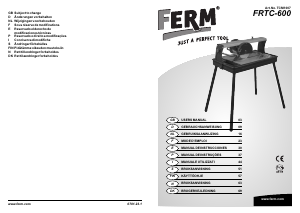
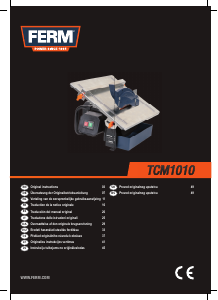
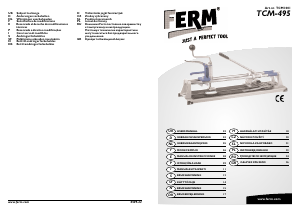
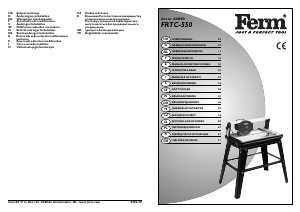
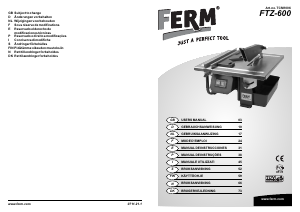
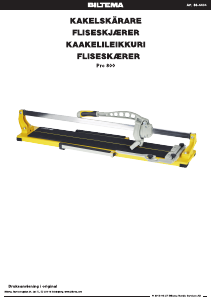
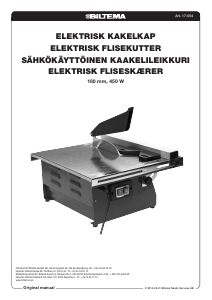

Deltag i samtalen om dette produkt
Her kan du dele, hvad du synes om FERM TCM1002 Fliseskæremaskine. Hvis du har et spørgsmål, skal du først læse brugsanvisningen omhyggeligt. Anmodning om en brugsanvisning kan ske ved at bruge vores kontaktformular.